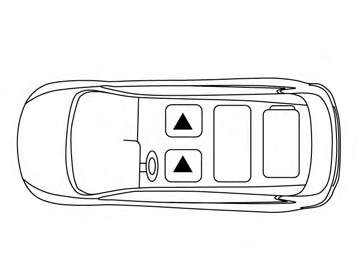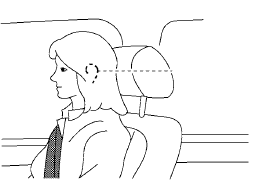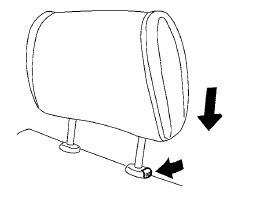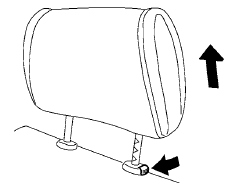Head restraints (1st row only)
WARNING
Head restraints supplement the other vehicle safety systems. They may provide additional protection against injury in certain rear end collisions. Adjust the head restraints properly, as specified in this section. Check the adjustment after someone else uses the seat. Do not attach anything to the head restraint stalks or remove the head restraint. Do not use the seat if the head restraint has been removed.
If the head restraint was removed, reinstall and properly adjust the head restraint before an occupant uses the seating position. Failure to follow these instructions can reduce the effectiveness of the head restraints. This may increase the risk of serious injury or death in a collision.

The illustration shows the seating positions equipped with head restraints. The first row head restraints are adjustable.
▲Indicates the seating position is equipped with a head restraint.

Components
1. Head restraint
2. Adjustment notches
3. Lock knob
4. Stalks

Adjustment
Adjust the head restraint so the center is level with the center of the seat occupant’s ears.

To raise the head restraint, pull it up.

To lower, push and hold the lock knob and push the head restraint down.

Removal (head restraints without Dual head restraint DVD system only)
Use the following procedure to remove the adjustable head restraints.
1. Pull the head restraint up to the highest
position.
2. Push and hold the lock knob.
3. Remove the head restraint from the seat.
4. Store the head restraint properly so it is not
loose in the vehicle.
5. Reinstall and properly adjust the head restraint
before an occupant uses the seating
position.

Install
1. Align the head restraint stalks with the holes
in the seat. Make sure the head restraint is
facing the correct direction. The stalk with
the adjustment notches 1 must be installed
in the hole with the lock knob 2 .
2. Push and hold the lock knob and push the
head restraint down.
3. Properly adjust the head restraint before an
occupant uses the seating position.
See also:
Flexible seating
WARNING
● Never allow anyone to ride in the cargo
area or on the rear seats when they are
in the fold-down position. In a collision,
people riding in these areas without
proper restraints a ...
Most common factors contributing to vehicle corrosion
• The accumulation of moisture-retaining
dirt
and debris in body panel sections, cavities,
and other areas.
• Damage to paint and other protective
coatings
caused by gravel and stone chips ...
Lights
Headlights
1. Headlight (high-beam)
2. Front turn signal/park/side marker light
3. Front map light
4. Ceiling light
5. Front fog light
6. Headlight (low-beam)
7. High-mounted stop light
8. C ...
